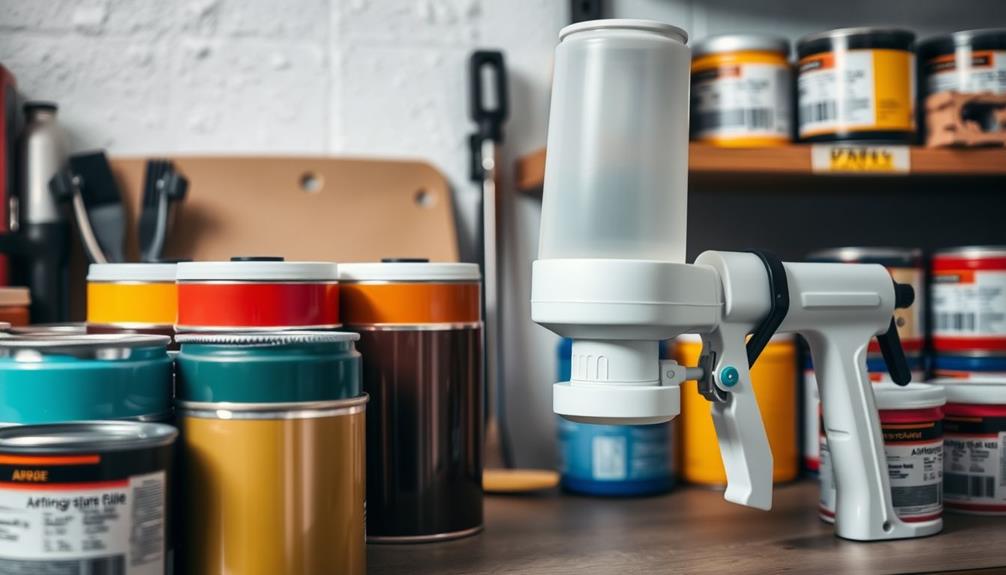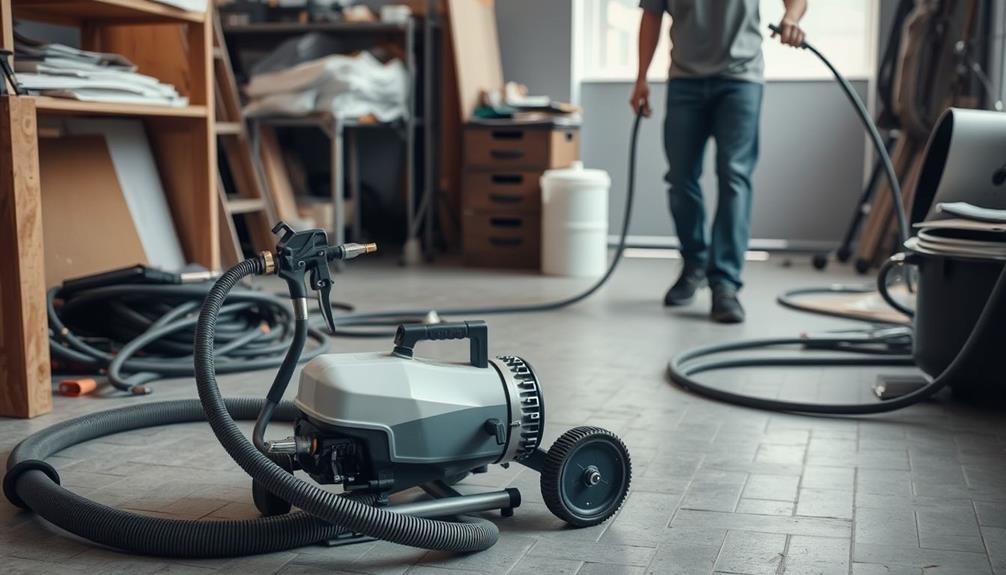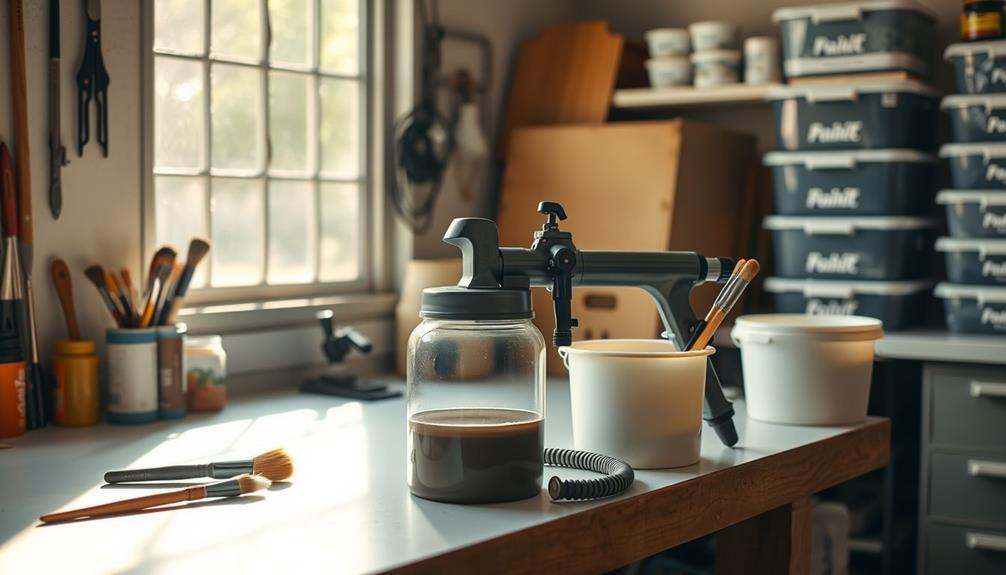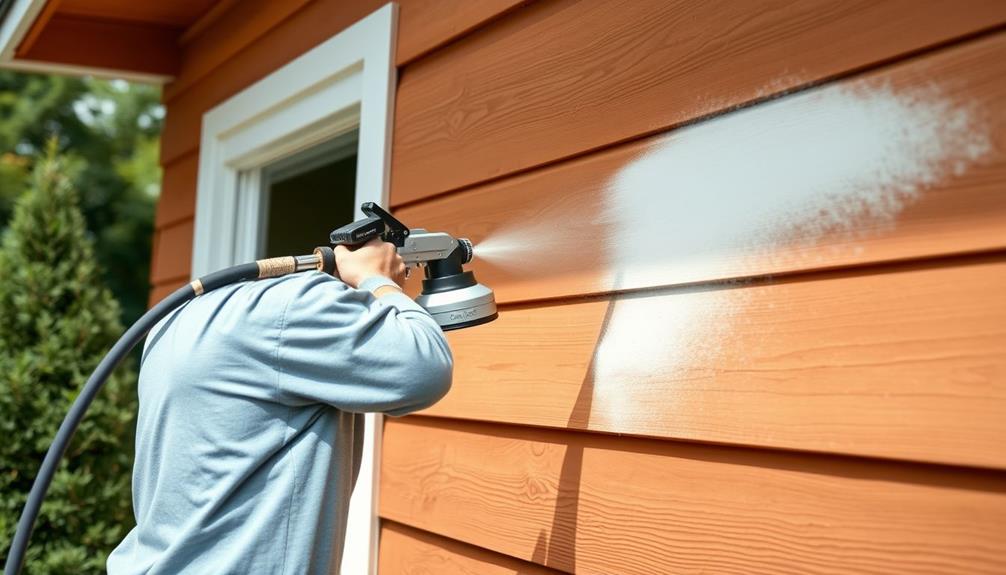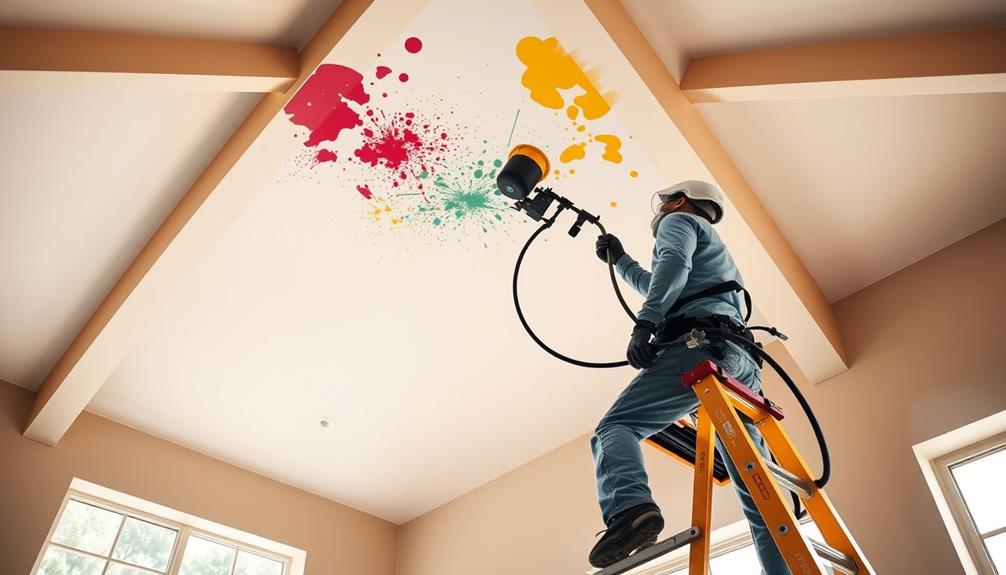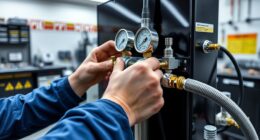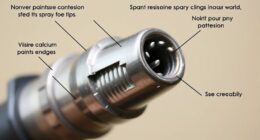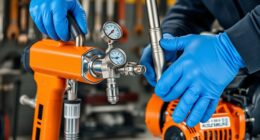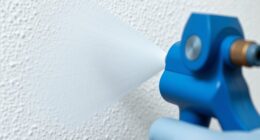To properly store leftover paint for your airless sprayer, seal the containers tightly right after use. Use lined metal or glass containers to minimize spoilage. Keep them in a dry area away from direct sunlight, ideally between 60-80°F. Inspect for leaks and signs of spoilage regularly. For longer storage, consider using preservative products like Graco Pump Armor or a DIY mineral spirits mix. Additionally, confirm your sprayer is clean and depressurized before storage. Following these tips will help maintain paint quality and sprayer performance, and you'll discover even more effective storage techniques as you explore further!
Key Takeaways
- Seal paint containers tightly using plastic wrap and check for leaks to prevent air exposure and spoilage.
- Store paint in lined metal cans or glass containers at 60-80°F (15-27°C) in a dry area away from sunlight.
- Regularly inspect stored paint for spoilage signs like sour odors or inconsistent texture, especially for opened paints lasting about two years.
- Clean the sprayer thoroughly with lacquer thinner, and use preservation products like Graco Pump Armor before long-term storage.
- Limit container sizes to reduce air exposure and maintain paint quality during both short and long-term storage.
Importance of Proper Storage
Proper storage of leftover paint is essential for maintaining its quality and guaranteeing your airless sprayers stay in top shape. When you store paint correctly, you help prevent corrosion and clogging caused by dried paint residue.
Airless paint sprayers are particularly sensitive to paint quality, so using lined metal cans or glass containers is a smart choice; they keep your paint fresh and reduce spoilage risk.
Make certain to store paint in a dry area, away from direct sunlight. Keeping it within a temperature range of 60-80°F (15-27°C) will greatly prolong its usability. It's also important to limit the sizes of your containers and reseal paint cans immediately after use. This minimizes air exposure, which is a key factor in paint degradation.
Regularly check your stored paint for signs of spoilage, like sour odors or inconsistent texture. By doing this, you guarantee that only usable paint gets applied, ultimately protecting your sprayer's functionality.
Recommended Pump Preservers
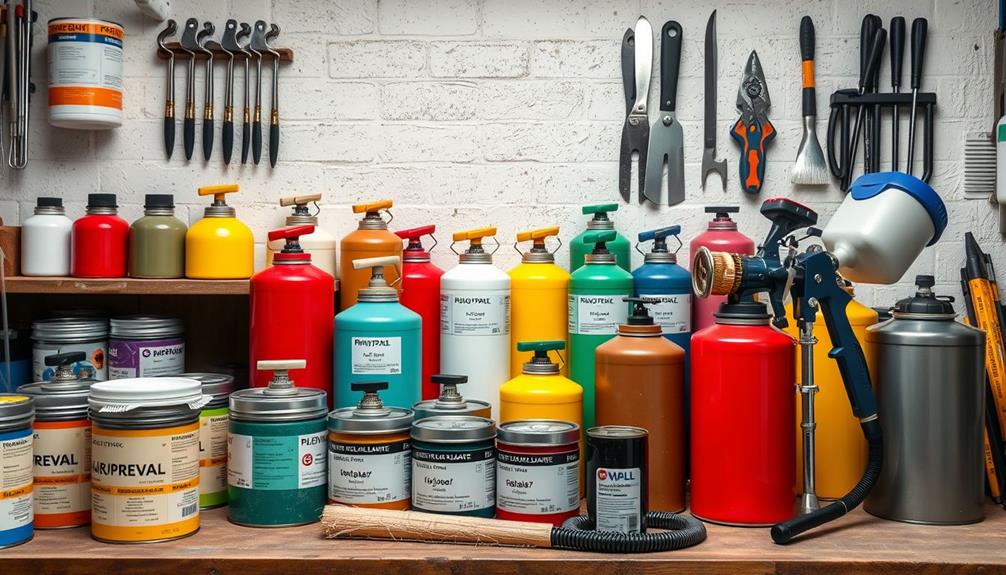
When it comes to preserving your airless sprayer, choosing the right pump preserver is essential. One of the top recommendations is Graco Pump Armor. This product effectively protects your sprayer from freezing and corrosion during storage, guaranteeing it remains in peak condition when you're ready to use it again.
Additionally, many budget-friendly options provide high performance without breaking the bank, making it easier to maintain your equipment. If you're in milder conditions, Titan Liquid Shield can also work, though keep in mind it's not freeze-proof.
For those who prefer a more DIY approach, mineral spirits can be used alone or mixed with engine oil to preserve your pump. Just make certain not to leave it in the hoses for too long, as that can lead to issues down the line.
If safety is a concern, there are non-flammable options available that enhance safety during storage and maintenance.
Ultimately, your choice of pump preserver should depend on your specific storage conditions, especially if you expect freezing temperatures. By selecting the right product, you can guarantee your airless sprayer stays protected and ready to tackle your next painting project.
Short-Term Storage Techniques
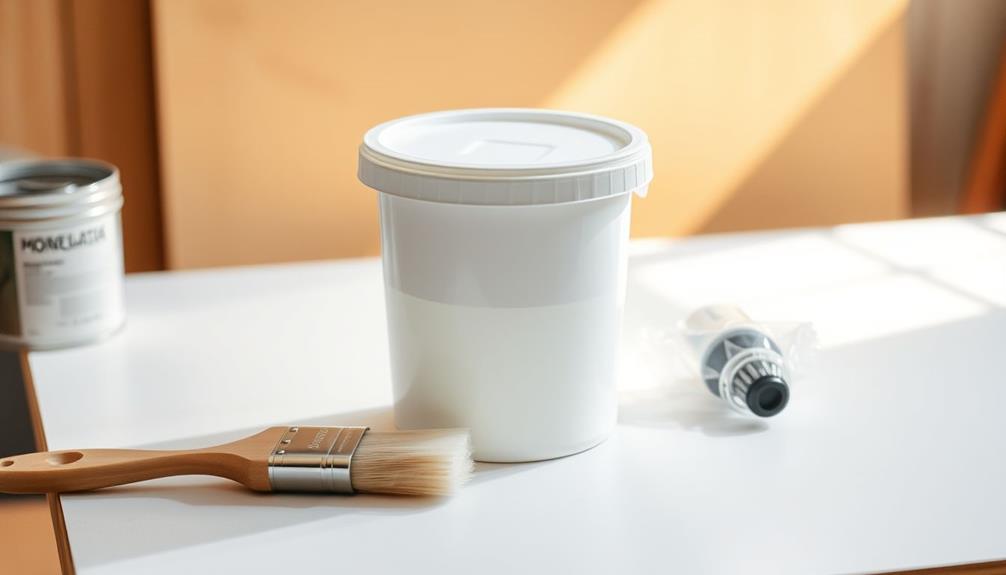
When you're storing leftover paint for a short period, it's crucial to cover the containers securely to prevent drying.
Utilizing proper filtration and pump protection can also enhance your sprayer's performance when you decide to use the paint again.
Using plastic wrap can create an airtight seal, keeping your paint fresh.
Also, make sure to keep the paint in a stable temperature range to maintain its quality.
Cover Paint Containers Securely
Your leftover paint deserves the best care to maintain its quality, and securely covering the containers is crucial. After you finish painting, make certain to seal your paint containers tightly right away. This prevents air exposure, which can dry out or spoil your paint. For short-term storage (up to a week), consider using a piece of plastic wrap. Cover the can with it before replacing the lid to create an airtight seal that minimizes evaporation.
Here's a quick reference table to help you remember the best practices for covering paint containers:
| Action | Description | Importance |
|---|---|---|
| Seal Immediately | Close the lid tightly right after use. | Prevents air exposure |
| Use Plastic Wrap | Place a piece of plastic wrap before the lid. | Creates an airtight seal |
| Check Seal Integrity | Inspect for leaks before storage. | Guarantees paint longevity |
| Store in Dry Area | Keep paint in a dry, temperate environment. | Maintains consistency |
| Avoid Sunlight | Keep containers away from direct sunlight. | Prevents quality degradation |
Maintain Ideal Temperature Range
Maintaining the ideal temperature range for leftover paint is vital for preserving its quality and usability. Store your paint in a temperate environment, ideally between 60-80°F (15-27°C). This range helps prevent spoilage and guarantees that the paint remains consistent and ready for your airless sprayer when you need it.
Regular maintenance of your equipment, like making sure your airless sprayer is clean and functional, also plays a significant role in achieving the best results in your painting projects, similar to how air purifiers improve indoor air quality.
Avoid exposing your paint to extreme temperature fluctuations, as this can negatively impact its performance. Direct sunlight is another enemy; keep your paint containers away from it to prevent drying out and degradation.
If you're working with oil-based paint, it's especially important to maintain this temperature range to make certain the pump operates smoothly without clogging.
Limiting the size of your paint containers can also work in your favor. Smaller containers reduce air exposure, helping to prevent thickening or drying out. Always seal your paint containers tightly after each use.
This simple step minimizes air exposure and maintains the integrity of your leftover paint during storage. By keeping your paint at the right temperature, you're setting yourself up for better results in your next project.
Use Plastic Wrap Seal
A simple yet effective technique for short-term storage of leftover paint involves using plastic wrap to seal the paint can and hoses tightly. This method minimizes air exposure, reducing the risk of skin formation on the paint's surface. To keep your paint fresh and ready for the next use, submerge the suction and drain tubes in the paint can before wrapping everything up.
Additionally, maintaining a clean workspace and having the right tools can notably improve your painting experience, making it easier to manage leftover materials effectively, similar to how one should consider key factors in choosing a home cleaning service.
While you're working, remember to release pressure from your Graco sprayer and keep the gun submerged in water during short breaks. This prevents clogging and guarantees smooth operation when you return. Just be cautious—avoid using this plastic wrap method in freezing temperatures, as the water can freeze and damage your sprayer components.
The effectiveness of this technique can vary based on heat and humidity, so try to apply it in a controlled environment for the best results. If you notice the paint thickening or drying out, you can always add a little paint thinner to restore its consistency before your next project.
This simple storage solution can save you time and hassle, keeping your airless sprayer ready for action.
Medium to Long-Term Storage
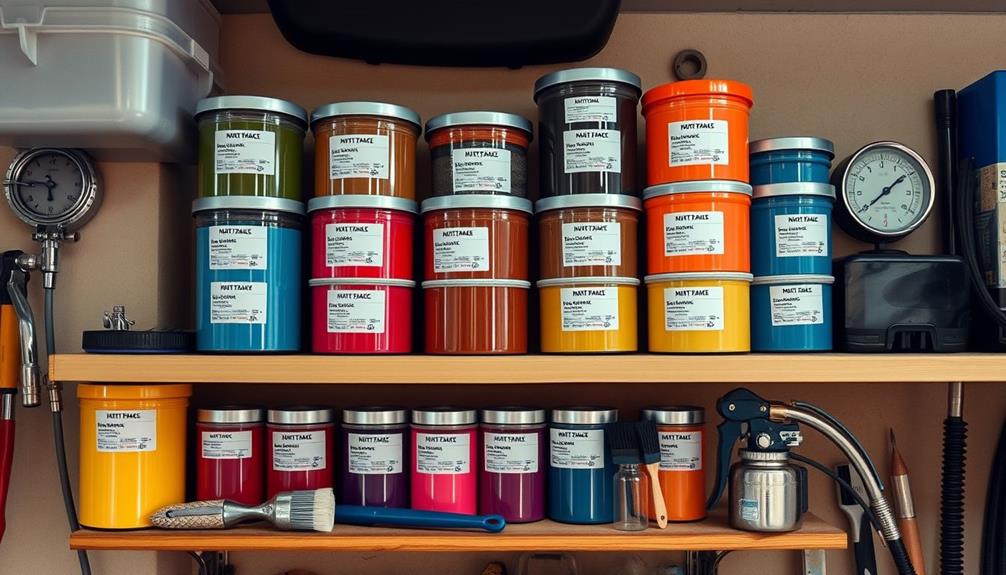
When you're storing paint for the medium to long term, proper cleaning and preparation are essential.
It's important to guarantee that the environment where you're storing the paint is free from strong odors that could affect the quality of the paint, as 10 smells cats hate may also impact the storage area.
You'll want to use the right storage solutions to keep your sprayer in top shape and prevent any corrosion.
Let's go through the steps you need to follow for effective storage.
Cleaning and Preparation Steps
To secure your airless sprayer remains in top condition for future use, proper cleaning and preparation are vital before storing it for the medium to long term. Start by thoroughly cleaning your sprayer with lacquer thinner, confirming no residue is left in the pump. This step is essential to prevent clogs that could compromise functionality. Before storage, relieve pressure by pulling the gun trigger to avoid potential damage from trapped pressure.
Next, use fresh mineral spirits or a pump preservative like Graco Pump Armor to protect internal components from corrosion and freezing. As you cycle the preservative through the system, apply several drops of Graco Throat Seal Liquid (TSL) to lubricate and protect all seals.
Finally, when you turn off the sprayer after applying the protectant, make sure the sprayer rod is in the down position. This positioning helps maintain proper seal integrity.
| Step | Importance | Emotional Impact |
|---|---|---|
| Clean with lacquer | Prevents clogs | Guarantees smooth operation |
| Use Graco Pump Armor | Protects from corrosion | Safeguards your investment |
| Secure seals | Maintains functionality | Peace of mind for future use |
Recommended Storage Solutions
For medium to long-term storage of leftover paint, choosing the right containers and conditions is vital. Start by using lined metal cans, glass, or plastic containers that can be sealed tightly. This minimizes air exposure, helping preserve the quality of the paint you plan to use with your paint sprayer later.
Incorporating unique cultural experiences into your home can also inspire your color choices and painting projects. A mix of mineral spirits and 30-weight oil can further protect the paint from corrosion.
Maintain a temperature range of 60-80°F (15-27°C) during storage. This prevents the paint from freezing or degrading due to extreme temperatures. To limit air exposure, opt for smaller containers whenever possible, and always inspect the seals of your containers to verify they're airtight.
Regularly check your stored leftover paint for signs of spoilage, like a sour smell or inconsistent texture. Most opened paints have a shelf life of about two years, so keeping tabs on their condition is important.
Very Long-Term Storage Tips
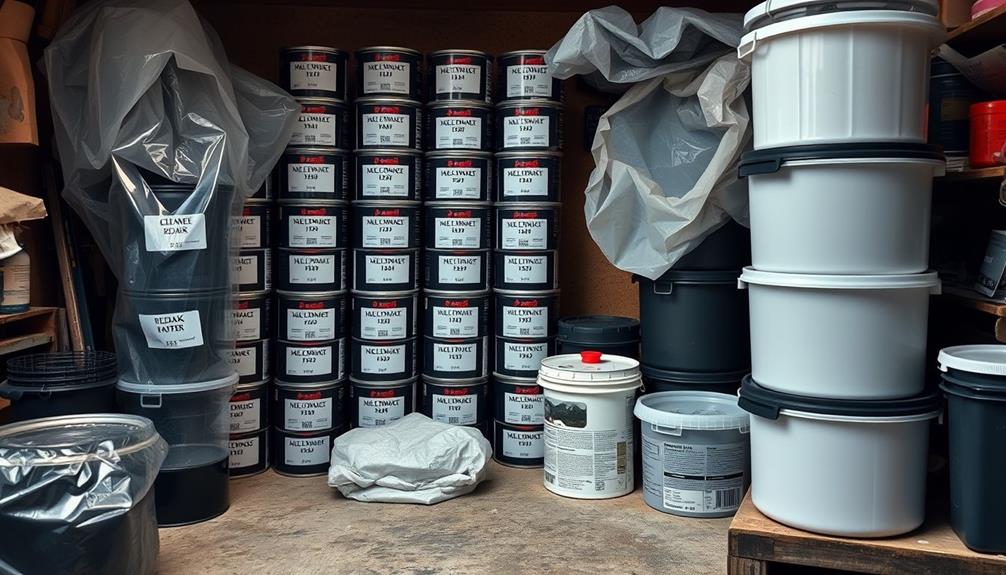
If you're looking to store leftover paint for an extended period, taking the right steps is essential to maintain its quality and protect your equipment.
Start by draining all water from your airless sprayer. This prevents corrosion and damage over time. For ideal preservation, mix mineral spirits with 30wt oil—use several cap-fulls of oil per quart of mineral spirits. This combination helps protect the pump and seals effectively.
Additionally, investing in a security system can further safeguard your tools and home during the storage period.
When you finish applying your protectants, keep the rod in the down position to avoid internal damage. Additionally, consider using specialized products like Graco Pump Armor or glycol-based anti freeze. These can provide enhanced protection against freezing conditions, ensuring your paint and equipment remain in top shape.
Here are some key tips for very long-term storage:
- Store the airless sprayer indoors in a climate-controlled environment.
- Avoid extreme temperatures and humidity to maintain paint quality.
- Regularly check the condition of the paint and equipment during storage.
Maintenance and Cleaning Procedures
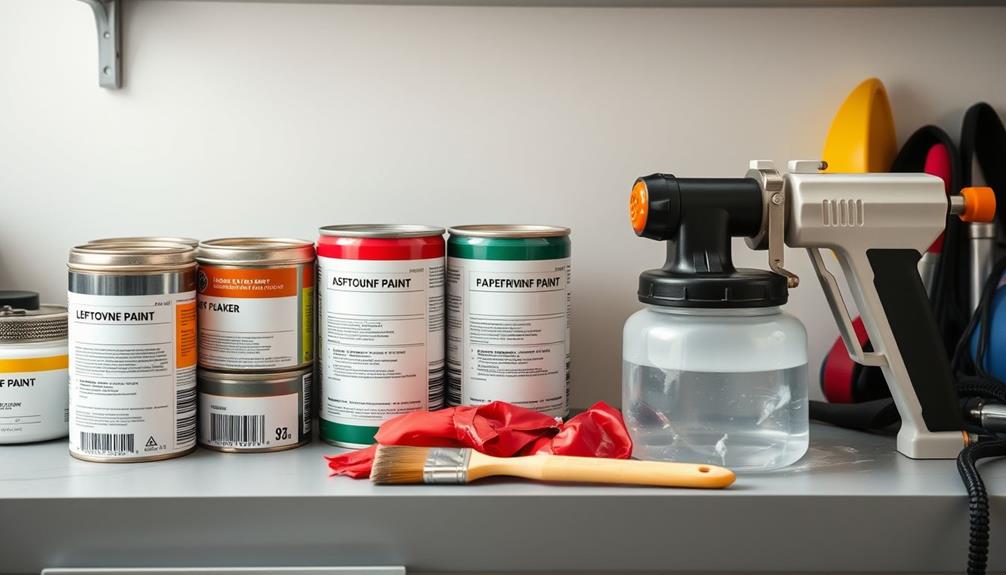
After guaranteeing your airless sprayer is properly stored for the long term, focusing on maintenance and cleaning procedures is essential for its longevity and performance.
Start by cleaning your sprayer thoroughly after each use. Flush it with a mixture of water and Dawn soap to remove any paint residues that could cause clogs. Additionally, it's important to contemplate energy consumption of appliances when using equipment like airless sprayers, as they can contribute to overall energy costs.
Once you've cleaned it, run clean water through the system to eliminate any soap residue, which can affect your future paint applications.
Regular maintenance includes checking and cleaning filters, spray tips, and the main gun. This practice helps maintain peak performance and reduces the risk of operational issues.
For deeper cleaning, think about running mineral spirits or a similar solvent through the system periodically, but make sure you don't leave it in the pump during storage.
Lastly, if you don't use your sprayer frequently, try to operate it every 4-5 years. This helps prevent pump seizure and keeps everything functioning smoothly.
Common Issues and Challenges
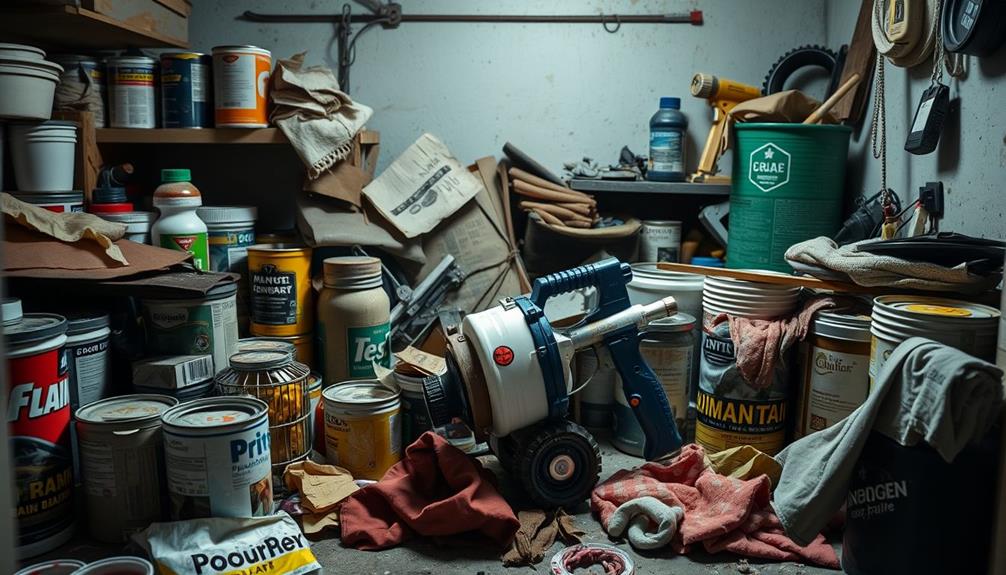
Storing leftover paint presents several common issues and challenges that can impact both your paint and equipment. If you don't take proper precautions, you might find yourself facing clogs in your airless sprayer. Dried residue can harden in hoses and tips, rendering them unusable.
Additionally, if you leave water in the system during colder months, it can freeze, damaging the pump assembly and leading to expensive repairs. To avoid these issues, it's essential to maintain your equipment, similar to how safety features in garage door openers enhance home security by preventing operational failures.
To help you navigate these challenges, consider the following:
- Properly seal paint containers to prevent spoilage and air exposure, which can alter paint consistency.
- Clean filters, spray tips, and hoses after use to avoid performance issues caused by dried paint residue.
- Regularly check stored paint and sprayers to identify potential issues early, ensuring peak performance.
Frequently Asked Questions
How Long Can Paint Be Left in an Airless Sprayer?
You can leave paint in an airless sprayer for about 1 hour to 3 days during breaks. However, avoid freezing temperatures, as they can damage the paint and the sprayer's internal components.
How Long Can You Leave Paint in a Sprayer Between Coats?
When you're in a pickle between coats, you shouldn't leave paint in the sprayer for more than an hour. Otherwise, it could clog up and cause you headaches during your project. Keep it clean!
How Do You Store an Airless Sprayer Between Coats?
To store your airless sprayer between coats, leave the suction and drain tubes submerged in paint, cover everything tightly with plastic wrap, and release pressure by pulling the trigger to protect the pump and seals.
Can You Leave Paint in Graco Sprayer?
You shouldn't leave paint in a Graco sprayer for long. It can clog and damage components. If you must take a break, keep the tubes submerged and cover the paint can tightly to reduce air exposure.
Conclusion
Properly storing your leftover paint isn't just about saving money; it's about preserving quality for your next project. While short-term techniques might seem easy, neglecting medium to long-term storage can lead to frustrating results. Just as a well-maintained airless sprayer guarantees a smooth finish, careful storage safeguards your paint's integrity. By following these tips, you can avoid the mess of dried-out paint and enjoy the satisfaction of a perfectly executed job every time.
